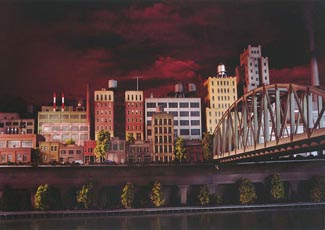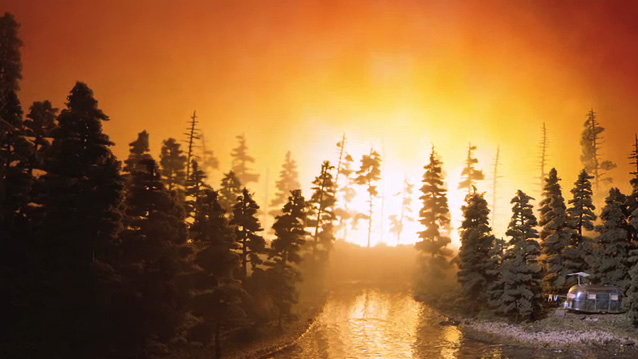An Interview with Lori Nix

Lori Nix makes highly–detailed dioramas that are playful and dark. An exhibition of her latest photographs opened at G. Gibson Gallery in Seattle yesterday and runs through 23 June 2007. (Click image for detail. More images after the jump.)
What made you start making these models in the first place? How did all this come about?
I was doing room–sized installations when I was in grad school. Once I left grad school and lost my studio space, I was living in a small attic apartment so I started working on table–top models. It was something that I could do in my little attic. I kind of wanted to explore my childhood of growing up in Kansas, but didn't necessarily want to travel to Kansas. I'm not the kind of person who likes to drive around and photograph. I'm much more hands on. So I decided to recreate certain aspects of my childhood that I remembered (actually kind of fondly) that were natural disasters—like tornadoes and the insect infestations.
There's a story about you chipping frozen frogs out of a pond in the winter and throwing them at your sister. Did that really happen?
Oh yeah! It was weird. It was a late freeze, and I remember being at this farmer's house and all these frogs' bodies were frozen into the pond. My brother and I started chipping them out and throwing them at one another and then at my sister.
What training do you have in doing this? Or did you just decide that it would be something you would be interested in doing, and then just barreled ahead with it?
I was a ceramics major in undergrad, so I was used to working with my hands and getting dirty. But as far as doing the models, I went to a local bookstore and bought one of those "how to" books on model railroading. Basically I just opened a book and started at it.
Your models are also becoming more and more complex. How much time goes into making them?
They take anywhere from three months to two years. I only work on one piece at a time because I'm doing these in the living room of my Brooklyn apartment. It's me and my girlfriend, Kathleen Gerber (who's kind of like my silent art partner), who are sitting in front of the TV and working on these models every night. Every once in a while, we'll have a third friend come in and we give him the hard tedious pieces—like making a chandelier the size of a softball, which may take him three or four months. Kathleen and I are constantly working. As soon as we get home from our day jobs, we get to work on the models. We work on them in the evenings, and on the weekends, and on our days off—and it still ends up taking seven months.
Your first series called "Accidentally Kansas" was filled with nature and natural disasters, and now your most recent work is called "Shadows of the City." The newer stuff seems to have less obvious humor than the earlier work and some of the scenes, even though they are incredibly beautiful, are also feel very "it's the end of the world." Can you talk about that progression?
There are still humorous things, but they're more tucked away. It's not quite so obvious. I started the whole model thing while I was living in Ohio, and then I transplanted myself to New York eight years ago. I'm getting older and life is getting harder. I think I have less of a carefree spirit. I have worry about bigger things, like bills and money. I think my whole nature is turning a little darker, just from living in an urban environment. I also think that I’m getting more mature in my work and taking bigger risks—wanting to do more grand–scale scenes. I think that if I transplanted myself back to the Midwest, the scenes would become more simplistic again, because I really feed off of my environment. I think just being in the city, I'm more interested in architecture and I'm seeing it everywhere I turn.
Part of the reason your images work so well is that they're slightly sinister. I mean, if they were models of cute scenes or situations, they just wouldn't work—there wouldn't be any tension in the picture. Like the picture of the snow storm, with the car that has swerved off the road fallen into an icy lake—that picture works because your first reaction is, "Oh isn't that a cute little winter scene," and then there's this second phase when you notice that the car has gone through the ice and the people in it have probably died, and your reaction completely changes.
I'm not really a cutesy person! When you pass by a car accident, I'm the type of person who's going to look. I'm drawn to the darker side of human nature. I'm interested in natural disasters and in human catastrophe.
Besides that, what influences you?
Reading. I take a lot of ideas from reading. I don't get to read nearly as much as I would like to. I've been buying a lot of books about the atomic bomb lately.
What work are you seeing right now that's blowing you away?
I'm always looking at landscape painting for colors and composition. I like looking at a lot of historical painting, specifically for scene composition. Tim Hawkinson is sculptor and every time he has a show in town I run out to see it. He has an interesting sense of humor that I like.












